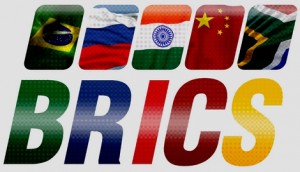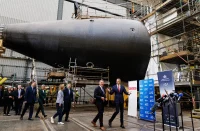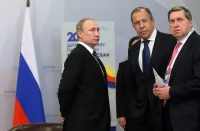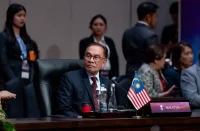An invisible plot is being hatched on the geo-political front. The BRICS countries plan to establish their own development bank to give loans for infrastructure projects, bypassing the middleman in the form of the U.S. dollar. If we consider that the BRIC countries account for 14.6% of the world’s GDP, the event is far from trivial. Many analysts project that by the middle of the 21st century, the BRICS’ economies will surpass the G7 countries in the West.
Every one of the BRICS countries is already regarded as a world leader in certain sectors of industry and science. Russia has undisputed authority in space exploration and nuclear energy, China is rapidly becoming a leader in the development and manufacturing of electronics, and India is a pharmaceutical giant, while South Africa and Brazil are at the top of the class in agriculture and biotechnology, respectively. The BRICS countries are now narrowing their commercial and economic priorities in order to retain and strengthen their economic achievements.
At the annual BRICS summits, the countries have managed to consolidate their efforts, work out collaborative development plans and have taken measures to significantly increase their trade turnover, reaching $340 trillion in 2012. The BRICS have carried out four high-level meetings in all where they discussed how they could correct the global political and economic imbalances, which favor developed countries. Over five years, the BRICS have taken steps to create a common independent financial institution despite the doubts and skepticism of Western analysts.
During the first summit in 2009 in Yekaterinburg, while seeking ways to overcome the global economic crisis, the countries immediately proceeded to develop joint investment projects. At the second summit in the Brazilian capital in 2010, they took the next step. After discussing trade difficulties between the four economies, they signed a series of important agreements between the members’ financial institutions, agreeing to cooperate on monetary policy. The third summit in 2011was held in China in the new BRICS format (which added South Africa) and represented the interests of four continents. There, the members agreed on the urgent need to reform the international monetary system and signed a framework agreement on mutual lending by the development banks of the participating countries in their national currencies.
And finally, at the fourth summit in New Delhi in 2012, the members agreed to create a joint BRICS bank.
Although Western analysts consider BRICS to be more of a symbolic entity and Western media tend to pay little attention to its activities, the majority of the decisions that the BRICS countries have made at the highest level have come to life. On the eve of the New Delhi summit, the BRICS research group analyzed the members’ discipline in implementing the bloc’s joint decisions. From April 2011 to March 2012, the average member-country had passed 70 percent of them. India fulfilled all of its obligations, while China and Brazil implemented 80 percent, Russia – 60%, and South Africa completed half.
On the doorstep of the next summit, the fifth of its kind, in Durban, South Africa March 2013, there is a high level of political activity in the capitals of participating BRICS countries and beyond, with delegations, business forums and working groups constantly passing through. BRICS finance ministers developed joint proposals to establish the new bank in February and it will be presented at the summit. According to the proposals, the bank’s initial capital will be set at $50 billion. The summit’s host is actively lobbying for its interests in the BRICS and vise versa. Egypt, Mexico and Indonesia will be considered for inclusion into the group in the near future.
The founding purpose of BRICS is to make itself into a firm economic and political base for further expansion and growth.
Pros
 The creation of joint financial institutions in the BRICS framework will certainly boost real economic cooperation between the member countries. Using the institutions for transactions and loans in their national currencies, the BRICS countries will increase investment within their borders and decrease their dependence on the world’s leading economies while completely eliminating the need to use the dollar or euro in domestic transactions. The ongoing instability of national currencies and the existing problems and risks in the economies of the U.S. and the EU make for a strong incentive to use the BRICS bank.
The creation of joint financial institutions in the BRICS framework will certainly boost real economic cooperation between the member countries. Using the institutions for transactions and loans in their national currencies, the BRICS countries will increase investment within their borders and decrease their dependence on the world’s leading economies while completely eliminating the need to use the dollar or euro in domestic transactions. The ongoing instability of national currencies and the existing problems and risks in the economies of the U.S. and the EU make for a strong incentive to use the BRICS bank.
The BRICS development bank also aims to become a sort of alternative to the IMF and World Bank for the BRICS space and those interested in investing there. The fact that the small percentage of support mechanisms available for developing countries are all in the hands international finance organizations controlled by the U.S. and the EU was one of the key arguments for the creation of the new bank. It is well known that the International Monetary Fund and the World Bank prefer to give out loans with terms that are not always friendly to the beneficiaries, but are always profitable for the U.S. and the EU.
By having their own development bank, BRICS countries would be protected from such an approach, especially because, according to some projections, the demand for investment capital in these countries will reach $15 trillion in just the next two decades. In order to start an active and long-term development of the African market, the member-states could immediately need $480 billion just to cover its deficit. Given the opportunities for large-scale investment projects in the fields of ecology, biofuel development, dams and nuclear power plants, this figure could grow several times.
Cons
Goldman Sachs estimated the total GDP of the BRICS to be more than $15 trillion. China leads the group with a GDP over $8 trillion, followed by Brazil ($2.5 trillion), Russia ($2 trillion), India ($2 trillion) and South Africa ($500 billion). The presence of an economic heavyweight like China could lead to serious disagreements when determining the general principles of the group.
Many economists doubt the viability of a BRICS bank because of the significant differences in the basic principles of the members’ financial systems, economic performance and growth rates.
The strategic goals of the BRICS member-states are also extremely varied. Leading analysts believe that China’s fundamental goal is to increase the geographical spread of its currency, the Yuan; the Indian government has prioritized attracting large-scale foreign investment; and Russia is interested in strengthening its geopolitical influence through economic growth, etc.
Meanwhile, tensions between India and China are not conducive to the long-term prospects for joint management of an international development bank. India is concerned with the rapid economic and military rise of its neighbor and rival in the region. In order to strengthen its geopolitical security in these circumstances, India has turned to cooperation with the United States, whose relationship with China is also cooling.
China’s undisputedly key economic role in the group will likely mean that the BRICS development bank will be headquartered in Shanghai. This is one more sore point ahead of the Durban summit, as South Africa intends to fight for the right to host the bank because a significant amount of the BRICS capital will go towards developing infrastructure in Africa. This proposal is also unlikely to find agreement with the rest of the BRICS members.
Furthermore, South Africa is unhappy with proposal that each member be responsible for supplying the bank with an equal share of capital — $10 billion – opting instead for a proportional contribution system. Russia’s position on the issue remains unclear. While in South Africa, Russian Foreign Minister Sergei Lavrov declined to comment on the matter, saying that discussions were still in the works.
In a highly competitive environment, the newly established financial institution will require a considerable amount of time to achieve the level of recognition, competence and capital equivalent to an authority in the field like the World Bank. Experts believe that several years will likely pass between the formal establishment of the BRICS development bank at the March Durban summit and the time when the first real loan will be granted. BRICS member-states will first need to go through a bevy of negotiations and consultations on how much capital will be sent where. Some of the countries, especially India, are in catastrophic need of improvements to internal infrastructure. Therefore, consensus has yet to be reached on where the new bank will spend its money.
Without a doubt, the creation of a new financial institution with an international scope designed to guard the interests of developing countries is very promising. But, the bank’s shareholders must share interests, develop a joint strategy and define common goals in order for it to function well in the long term. The BRICS countries have one positive example in front of their eyes – the European Monetary Union. This same story can serve as a negative example, allowing them to highlight Europe’s missteps and avoid them in time.
Only time will tell whether Russia, China, Brazil, India and South Africa will be able to put these lessons into practice.
Source in Russian: War & Peace














Comments